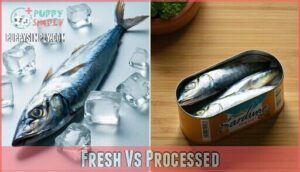This site is supported by our readers. We may earn a commission, at no cost to you, if you purchase through links.
 Yes, dogs can eat canned sardines safely when chosen and served correctly.
Yes, dogs can eat canned sardines safely when chosen and served correctly.
These omega-3 rich fish offer excellent protein, support skin and coat health, and contain minimal mercury since they’re low on the food chain.
However, you’ll need to select sardines packed in water—not oil—and avoid varieties with salt, garlic, or onions that can harm dogs.
Start with small portions: roughly one sardine per 10 pounds of body weight, served 2-3 times weekly maximum.
While most dogs handle the soft bones in canned sardines just fine, fresh boneless varieties eliminate any choking concerns completely.
The key lies in understanding which types work best and how proper portioning transforms these nutritious fish into a healthy treat rather than a dietary mistake, making them a great source of protein and support for skin and coat health.
Table Of Contents
- Key Takeaways
- The Benefits of Canned Sardines for Dogs
- Can Dogs Eat Canned Sardines?
- Considerations for Feeding Canned Sardines to Dogs
- Choosing The Right Canned Sardines for Dogs
- Introducing Canned Sardines to Your Dog’s Diet
- Potential Risks and Allergies
- Frequently Asked Questions (FAQs)
- How often should I Feed my Dog sardines?
- Can dogs eat sardines in olive oil?
- Can dogs eat sardines?
- Can you feed canned sardines?
- Are frozen sardines good for dogs?
- Do sardines eat a complete diet?
- Are There Any Risks to Feeding Your Dog Sardines?
- Can Dogs Eat Canned Sardines?
- What Other Canned Fish For Dogs Should I Consider?
- How Should I Go About Feeding Dogs Sardines?
- Conclusion
Key Takeaways
- Choose water-packed sardines only – You will avoid harmful oils and excess sodium that can cause digestive upset and dehydration in your dog.
- Stick to proper portions – You should feed roughly one sardine per 10 pounds of body weight, 2-3 times weekly, at a maximum, to prevent overfeeding complications.
- Skip dangerous additives – You must avoid sardines with salt, garlic, onions, or heavy seasonings that can be toxic to dogs.
- Start small and monitor – You will want to introduce sardines gradually, with quarter-portions first, watching for any allergic reactions or digestive issues.
The Benefits of Canned Sardines for Dogs
You’ve probably heard that fish is good for dogs, but canned sardines pack an especially powerful nutritional punch for your furry friend.
These small, oily fish deliver concentrated doses of omega-3 fatty acids, high-quality protein, and essential vitamins that can transform your dog’s health from the inside out.
Overall Health Benefits
When you’re looking for a nutrient boost for your dog, sardines deliver exceptional sardine benefits dogs need.
These small fish provide thorough canine health benefits through their rich omega3 fatty acids content, supporting immune support and brain function simultaneously.
Key overall health advantages include:
- Digestive Aid: Promotes healthy gut function and nutrient absorption
- Energy Levels: B vitamins enhance metabolic processes and vitality
- Immune Support: Essential nutrients strengthen your dog’s natural defenses
Sardines for dogs offer a complete wellness package.
The high-quality protein aids muscle development while vitamins and minerals support ideal sardines dog health.
This nutritional powerhouse helps maintain your pup’s overall well-being naturally.
Skin and Coat Health Benefits
Your dog’s coat can transform from dull to dazzling with sardines’ omega-3 powerhouse. These healthy skin nutrients tackle skin issues while promoting shiny fur naturally.
The omega benefits include reduced inflammation and enhanced moisture retention. Regular sardine benefits dogs by delivering essential fatty acids that support fur care from within.
Sardines good dogs receive show improved coat texture and fewer skin problems. This omega3-rich fish provides thorough skin and coat health support.
Joint Health Benefits
Your dog’s joints need omega-3 fatty acids to fight inflammation and maintain mobility.
Canned sardines deliver these powerful nutrients that can reduce joint pain by up to 70% according to research studies.
When you feed sardines for dogs regularly, you’re providing natural inflammation relief that targets stiff, achy joints.
The omega3 content works like a gentle lubricant for cartilage health, keeping your pup moving smoothly.
This is especially beneficial for arthritis prevention in aging dogs.
Sardines also pack calcium for bone strength and selenium that protects joint tissues from damage.
The high-quality protein supports muscle development around joints, creating better stability and support.
These nutritional powerhouses offer complete canine health benefits that keep your dog active and comfortable.
For ideal joint health and dog nutrition, sardines provide a safe, natural alternative to synthetic supplements.
Ocular Health Benefits
Beyond joint support, sardines offer remarkable Vision Care benefits for your dog’s Eye Wellness. The omega-3 fatty acids, particularly DHA, support Retina Health and Canine Optics development.
These antiinflammatory properties help reduce eye irritation, while vitamin D and vitamin B12 contribute to overall Eye Nutrition and canine health.
- Enhanced visual acuity through DHA’s role in retinal function
- Reduced eye inflammation from omega-3’s anti-inflammatory effects
- Better night vision supported by vitamin A content
- Protection against age-related eye diseases through antioxidant properties
Heart Health Benefits
In regards to your dog’s cardiovascular health, sardines pack a powerful punch.
These small fish contain omega-3 fatty acids that work like nature’s own heart medicine, reducing inflammation and supporting healthy blood flow.
The antiinflammatory properties help protect against heart disease by keeping blood vessels flexible and reducing strain on your pup’s ticker.
Coenzyme Q10 in sardines acts as fuel for heart muscle cells, boosting energy production where it’s needed most.
Unlike omega6 oils that can promote inflammation, sardines provide the good stuff your dog’s heart craves.
Think of fish oil as cardio health insurance – it’s an investment in your pet’s long-term wellbeing.
Regular sardine consumption supports ideal cardiovascular function, helping your furry friend maintain an active lifestyle well into their golden years.
Can Dogs Eat Canned Sardines?
Yes, dogs can safely eat canned sardines when properly prepared and served in moderation.
Choose plain sardines packed in water without added salt, oils, or seasonings to avoid potential health complications.
Raw Vs Cooked
When choosing between raw and cooked sardines for your dog, you’ll want to stick with cooked options for maximum safety and nutrition.
Raw feeding may seem natural, but it comes with significant risks that can put your pup’s health at stake. The nutritional benefits of sardines, including their omega 3 sources content, make them a valuable addition to a dog’s diet when prepared correctly, considering the importance of proper fish oil supplements.
Here’s why cooked sardines win the safety battle:
- Eliminates thiaminase enzyme – Raw sardines contain this compound that breaks down vitamin B1, potentially causing deficiency
- Destroys harmful bacteria and parasites – Cooking methods like steaming or baking eliminate foodborne pathogens
- Improves nutrient retention and absorption – Heat makes omega-3s and other nutrients more bioavailable
Food safety concerns make raw vs cooked sardines for dogs a clear choice. Raw sardines can trigger digestion issues and expose your pet to unnecessary health risks. Cooked sardines maintain their nutritional punch while being gentler on your dog’s digestive system.
Whether you’re exploring canned sardines dogs love or creating dog sardine recipes, always choose properly cooked options to keep your furry friend healthy and happy. For ideal dog health, consider the benefits of omega 3 sources when deciding on sardine-based meals.
Types of Canned Sardines
When choosing canned sardines for your dog, you’ll find several options that vary substantially in nutritional value and safety.
Water-packed sardines are your best bet since they contain minimal additives and preserve the natural omega-3 content.
Oil-packed varieties can work too, but avoid those with vegetable oils that may cause digestive upset.
Salt content becomes a major concern with many commercial brands.
Wild-caught sardines typically offer superior nutrition compared to farm-raised options, with higher omega-3 levels and fewer contaminants.
Skip flavored sardines entirely – they often contain garlic, onions, or other ingredients toxic to dogs.
The key is reading labels carefully.
Look for "no salt added" or "low sodium" options when selecting canned sardines dogs can safely enjoy.
Plain, water-packed varieties give you the most control over what your pup consumes.
Checking the canned sardines market can provide valuable insights into the various types of sardines available.
Considerations for Feeding Canned Sardines to Dogs
While canned sardines offer significant nutritional benefits for dogs, you’ll need to take into account important factors before adding them to your pet’s diet.
Mercury levels and proper portion control are essential considerations that determine whether sardines become a healthy treat or a potential health risk.
Mercury Levels
Mercury concerns around canned sardines are often overblown, but understanding the facts helps you make informed decisions.
Research shows canned sardines contain remarkably low mercury levels, averaging just 0.013 parts per million—among the lowest of all commercial fish species. This concentration is well below safety thresholds for both humans and dogs.
Sardines’ position as small, short-lived fish low on the food chain means they accumulate minimal mercury compared to larger predatory species.
Here’s what you need to know about mercury content:
- Low bioaccumulation: Sardines’ rapid growth and short lifespan limit mercury buildup
- Regulatory safety: FDA testing confirms sardine mercury levels remain consistently safe
- Comparative advantage: Sardines contain five times less mercury than canned tuna
- Quality sourcing: Reputable brands maintain strict quality control for heavy metal contamination
When fed in moderation, mercury toxicity from sardines poses virtually no risk to healthy dogs.
For more information on safely feeding dog food options to your pet, consult a veterinarian before making any changes to their diet.
Portion Control
Proper portion control when feeding sardines for dogs requires careful attention to serving sizes and feeding guidelines.
Your dog’s weight determines daily rations – dogs under 30 pounds should receive half a sardine two to three times weekly, while larger breeds can handle up to one full sardine per serving.
The key to successful meal planning lies in maintaining nutrient balance.
Can dogs eat sardines daily? No – limit sardine treats to maximum 10% of your dog’s total caloric intake.
This prevents sodium overload and digestive upset while ensuring your pup receives ideal nutrition.
Start with smaller dog serving size portions when introducing sardines, gradually increasing based on your pet’s tolerance.
Monitor for signs of stomach upset or weight gain.
Always choose no-salt-added varieties to avoid complications.
Following these dog feeding guidelines helps your furry friend enjoy sardines safely while reaping their impressive health benefits.
Choosing The Right Canned Sardines for Dogs
When selecting canned sardines for your dog, you’ll want to make smart choices that prioritize their health and safety.
Not all canned sardines are created equal, and the wrong type can turn this nutritious treat into a health hazard.
Fresh Vs Processed
When choosing between fresh and canned sardines for dogs, fresh options typically offer superior nutrient retention compared to processed alternatives.
Processing methods like smoking or canning can reduce some vitamins and minerals, though sardines for dogs remain nutritionally valuable either way.
Fresh sardines provide maximum omega-3 fatty acids and protein content, making them the gold standard for can dogs eat sardines discussions.
However, canned sardines packed in water offer convenience and longer shelf life through preservation techniques that maintain most essential nutrients.
The key difference lies in preparation time and cost.
Fresh options require careful deboning and cooking, while canned alternatives are ready to serve.
Both forms support your dog’s health when dogs eating sardines becomes part of their routine.
Consider your lifestyle when deciding – fresh sardines demand more preparation but offer peak nutrition, while quality canned sardines provide nearly identical benefits with added convenience for busy pet parents.
For peak nutrition, selecting high-quality canned dog food options that are rich in nutrients is vital to select.
Ingredients to Avoid
When scanning ingredient labels, you’ll want to steer clear of several harmful additives that can turn a healthy treat into a health hazard. Added salt tops the danger list – some canned sardines pack over 300 mg of sodium per serving, which can spike your dog’s blood pressure and cause dehydration. Preservatives like BPA can disrupt hormones and triple toxin levels in your pet’s system.
Skip sardines packed in brine or flavored with garlic, onion, or spices – these ingredients are toxic to dogs and can cause serious gastrointestinal upset. Oil-packed varieties double the fat content, increasing pancreatitis risk.
Mercury content and heavy metals accumulate with frequent feeding, particularly concerning for dogs with kidney issues. Watch for fish bones that weren’t properly processed – they create choking hazards and can splinter.
Raw sardines carry thiamin deficiency risks due to enzymes that destroy essential B vitamins. Sodium levels exceeding your dog’s needs can lead to poisoning symptoms like vomiting and lethargy.
Choose plain, water-packed sardines with minimal ingredients for the safest option. Understanding omega 3 benefits is essential for making informed decisions about your dog’s diet.
Introducing Canned Sardines to Your Dog’s Diet
When introducing sardines for dogs into your pet’s routine, take a gradual approach to guarantee proper canine digestion and pet safety.
Start small and monitor your dog’s response to this new addition to their canine sardine diet.
Here’s your step-by-step feeding guidelines for sardine preparation:
- Begin with quarter-portions – Offer just a small piece of deboned sardine to test tolerance
- Choose water-packed varieties – Avoid oil-based options that may upset sensitive stomachs
- Remove all bones carefully – Even soft bones can pose risks for smaller breeds
- Mix with regular food – Blend sardines with familiar kibble to ease the switch
- Monitor for 24-48 hours – Watch for any digestive upset or unusual behavior
This methodical approach to dog nutrition guarantees your pup reaps the omega-3 benefits while avoiding digestive issues.
Most dogs adapt well within a few feedings, making sardines dogs eat regularly a healthy addition to their diet.
Understanding omega-3 fatty acids is vital for maintaining a balanced canine diet.
Potential Risks and Allergies
While canned sardines offer numerous health benefits for dogs, you’ll need to watch for potential risks that could affect your pet’s safety.
Some dogs may experience choking hazards from bones or develop allergic reactions, making careful introduction and monitoring essential.
Choking Hazards
Sardine bones pose real choking risks for dogs, especially smaller breeds.
Fish bones can lodge in your dog’s throat or cause digestive blockages if swallowed whole.
The safest approach involves thorough bone removal before serving.
Small objects like fish bones become dangerous when dogs gulp food without proper chewing.
Watch for choking signs: pawing at the mouth, excessive drooling, gagging, or difficulty swallowing.
Large cooked sardines present greater choking hazards than soft canned varieties.
Even tiny bones can splinter and cause internal damage.
Prevention beats treatment every time.
Always supervise feeding and choose boneless options when possible.
Your dog’s safety depends on careful preparation and mindful portion control, ensuring proper chewing and avoiding choking hazards at all times, with supervise feeding being crucial.
Allergic Reactions
Although rare, food allergies can affect dogs who eat sardines. Watch for itching symptoms, skin issues, or digestive problems after feeding.
Fish allergy signs include excessive scratching, ear infections, or stomach upset. Severe allergic reactions like anaphylaxis require immediate veterinary care.
Most dog allergies involve common proteins, making sardines relatively safe. However, canine dietary restrictions vary individually.
Introduce sardines gradually, monitoring for any adverse reactions to guarantee pet safety.
Frequently Asked Questions (FAQs)
How often should I Feed my Dog sardines?
A dog owner noticed their golden retriever’s coat became shinier after adding sardines twice weekly.
Feed sardines 1-3 times per week in moderation—too frequent feeding can cause digestive upset and sodium overload from canned varieties, which can be mitigated by feeding in moderation.
Can dogs eat sardines in olive oil?
Yes, dogs can eat sardines packed in olive oil, but it’s better to choose sardines in water.
Olive oil adds extra calories and fat that aren’t necessary for your dog’s diet and could potentially cause stomach upset.
Can dogs eat sardines?
Dogs can safely eat sardines when prepared properly.
You’ll want to choose plain, cooked sardines without added salt or seasonings.
Remove any bones first, and serve them as an occasional treat rather than a daily meal.
Can you feed canned sardines?
Max, a golden retriever, suffered digestive upset after his owner fed him sardines packed in brine daily.
You can feed canned sardines to dogs, but choose water-packed, salt-free varieties.
Serve 1-3 times weekly in moderation to avoid sodium poisoning.
Are frozen sardines good for dogs?
Frozen sardines offer excellent nutritional benefits for dogs when properly prepared.
They’re actually fresher than canned options, and to serve them, you’ll need to thaw them completely, remove backbones, and cook them thoroughly before serving.
Do sardines eat a complete diet?
Wild sardines consume roughly 80% zooplankton and 20% phytoplankton, creating a naturally balanced marine diet.
However, you shouldn’t rely on sardines as your dog’s complete nutrition source – they lack essential nutrients like carbohydrates and certain vitamins.
Are There Any Risks to Feeding Your Dog Sardines?
Yes, feeding sardines to dogs carries several risks you should consider.
High sodium content in canned varieties can cause dehydration and poisoning.
Small bones pose choking hazards, while overfeeding may trigger digestive upset or weight gain in susceptible dogs, which can be a significant concern for digestive health.
Can Dogs Eat Canned Sardines?
Dogs can eat canned sardines safely when they’re packed in water without added salt. Choose plain, deboned varieties and serve in moderation to avoid digestive upset from excess sodium.
What Other Canned Fish For Dogs Should I Consider?
Like a treasure chest hidden beneath the waves, the ocean offers many nutritional gems for your canine companion.
Consider canned salmon, mackerel, and tuna as excellent alternatives to sardines.
These options provide similar omega-3 benefits while offering variety in your dog’s diet.
How Should I Go About Feeding Dogs Sardines?
Start by choosing plain canned sardines packed in water without added salt.
Remove any visible bones, then serve 1-2 sardines for small dogs or 2-4 for larger breeds, 2-3 times weekly as treats.
Conclusion
Despite concerns about bones, most dogs safely digest sardines’ soft, edible bones.
When choosing canned sardines, you’re making a smart decision for your pet’s health. These omega-3 powerhouses support joint mobility, heart function, and cognitive development.
However, the question of whether can dogs eat canned sardines requires careful selection—choose water-packed varieties without added salt, garlic, or onions.
Start with small portions, monitor for allergic reactions, and consult your veterinarian before introducing new foods to guarantee the best health benefits.
- https://pangovet.com/?utm_source=dogster&utm_medium=article&utm_campaign=dog_eat_drink
- https://www.fda.gov/food/environmental-contaminants-food/mercury-levels-commercial-fish-and-shellfish-1990-2012
- https://mbimph.com/index.php/UPJOZ/article/download/3671/3313/5809
- https://www.masterclass.com/articles/can-dogs-eat-sardines
- https://www.universityofcalifornia.edu/news/preliminary-study-suggests-mercury-not-risk-dog-foods










